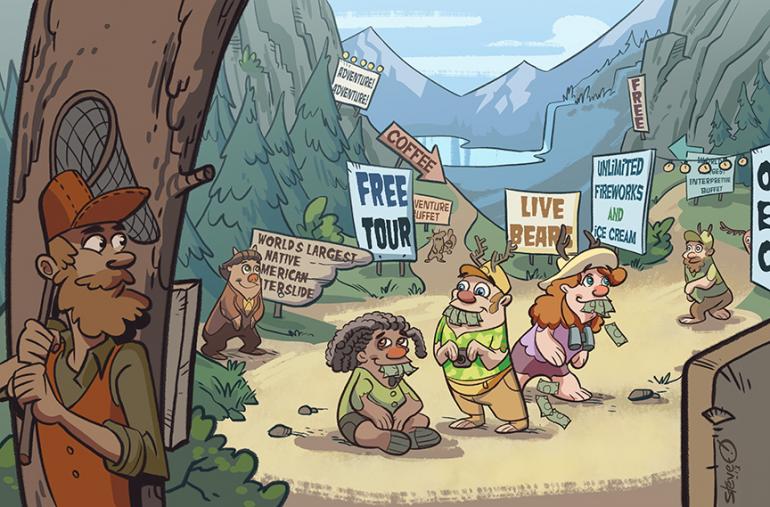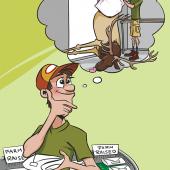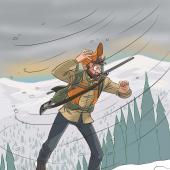Tourist Trap
The season is open.
Mine is a worthy prey. His home range is expansive, and in his element, he is King of Beasts. His numbers are large and growing. He is smart, he is elusive, and he is dangerous. In short, he is the ultimate hunt, for the ultimate hunter. He is the Touron.
If you’ve never hunted during one of the region’s seasonal migrations of Touron, I highly recommend you try it sometime. No guns, no arrows, no ATVs, no pack horses. No, the tactics, tools, and payoff in this age-old cat-and-mouse game are different than any other hunt. This hunt is about strategy and precision.
He comes here on the prowl, sniffing around for a taste of the good life. He shows up without warning and in great numbers—swarms that can track out an entire ski area before 11am, empty rivers of their fish, and flush every wild critter from the mountains. He is a plague, in this sense. He consumes goodness—it’s simply what the Touron has evolved to do.
But he leaves behind as much as he takes. In his consumptive wake, the Touron deposits a steady trail of dollar bills, fertilizing our commercial apparatus. Some argue that Touron dollars are worthless, at least compared to the price we pay. But that’s not for me to decide. I’m just a hunter.
Now, it must be known that not all Tourons are created equal. There are subspecies of Touron—the Urbanite, the Family Group, the Perpetual Nomad, the Extreme Guy, the Burnout, the Trustafarian, the Biker, the Yuppie—hell, maybe there’s an entire Touron taxonomy. It doesn’t really matter to me. My only concern is the manner in which I might lure one into my snare.
The Touron is too smart, in most cases, to be taken by an archaic hook-and-bullet philosophy. He must be outsmarted, outplayed, tricked into the trap. There are many methods of hunting the Touron, but for baiting the trophy specimens, presentation is everything. You see, friend, the Touron is always looking for something better than what he has.
He roams about, in search of whatever might be lacking from his life: adventure, excitement, beauty. Sometimes he finds it—pretty damn often around these parts—and that’s when the trouble begins. He boxes it up, he fences it in, and he stops anyone else from experiencing that particular piece of happiness, until all that’s left are shattered prismatic bits, distorting the light of what used to be. That’s the problem with the Touron.
Bagging a big one—a true Touron trophy—requires a certain amount of deception. Not flat-out dishonesty, of course, but a gifted hunter must know how to create an atmosphere conducive to the suspension of disbelief. The trick is to stretch the truth—reality—into the realm of myth: to push the idea of possibility beyond the limit of attainability. We must make the Touron want something—a view, an experience, a trophy of his own—that he thinks only this place can provide. And then there’s the matter of bait.
The Touron, for all his talents, is a terribly predictable creature. He has deeply rooted, genetically ordained instincts that compel him to pursue the cliché and the familiar. These instincts—along with neurotic souvenir-hoarding tendencies—lead to behavior that can be used to the hunter’s advantage.
The Touron is powerless against his nature when confronted with signs containing certain key words, and he may become disoriented or hyper and lose practical inhibitions in the presence of such lures. I once watched a master hunter live-trap 173 mature, trophy Tourons in a single hour with a lethal sign that read: “Adventure Tour! Free Coffee, Interpretive Fireworks, and Native American Ice Cream Buffet at the World’s Largest Live Bear Waterslide.” She culled 15 or 20 big ones from the herd before turning ‘em loose to mature and reproduce. Not that the population is in trouble. There are more Tourons every year.
Certain breeds of Touron will come to us, offer us huge sums of money to punish them physically and mentally in the mountains for a day or a week, and then offer us more money to do it again next year. The lucky few who get this kind of action are outfitters and guides. They have the system licked.
Ours, however, is a strictly catch-and-release harvest. We rely on the Touron too much; we need him as much as he needs this place—or, rather, the idea of this place. So we release him back into the wild, and wish him well and to “come again!” That’s not to say you can’t collect sheds. I’ve got a matched pair mounted in my game room—two gleaming pleather fanny-packs tastefully presented on a walnut backing.
You don’t need a license for this hunt. It’s an unlimited, unsupervised, winner-takes-all throwdown out there. Print a sign, build a snare, or just sit back and watch the action. It’s open season on the beast we call the Touron.












